Nothing but problems, problems and more with OWC Thunderbay 4. Brand new MacBook Pro. Updated. I've had the thing for two years or so. Doesn't work if Mail is open...problems with Apple Photos...enough. Thankfully, mercifully no data loss. Small favors.
With the ThunderBay 8, OWC expands its vast range of professional-grade Thunderbolt accessories, offering an ultra high-capacity storage solution with eight hot-swappable universal bays for 3.5- or 2.5-inch hard drives or SSDs.
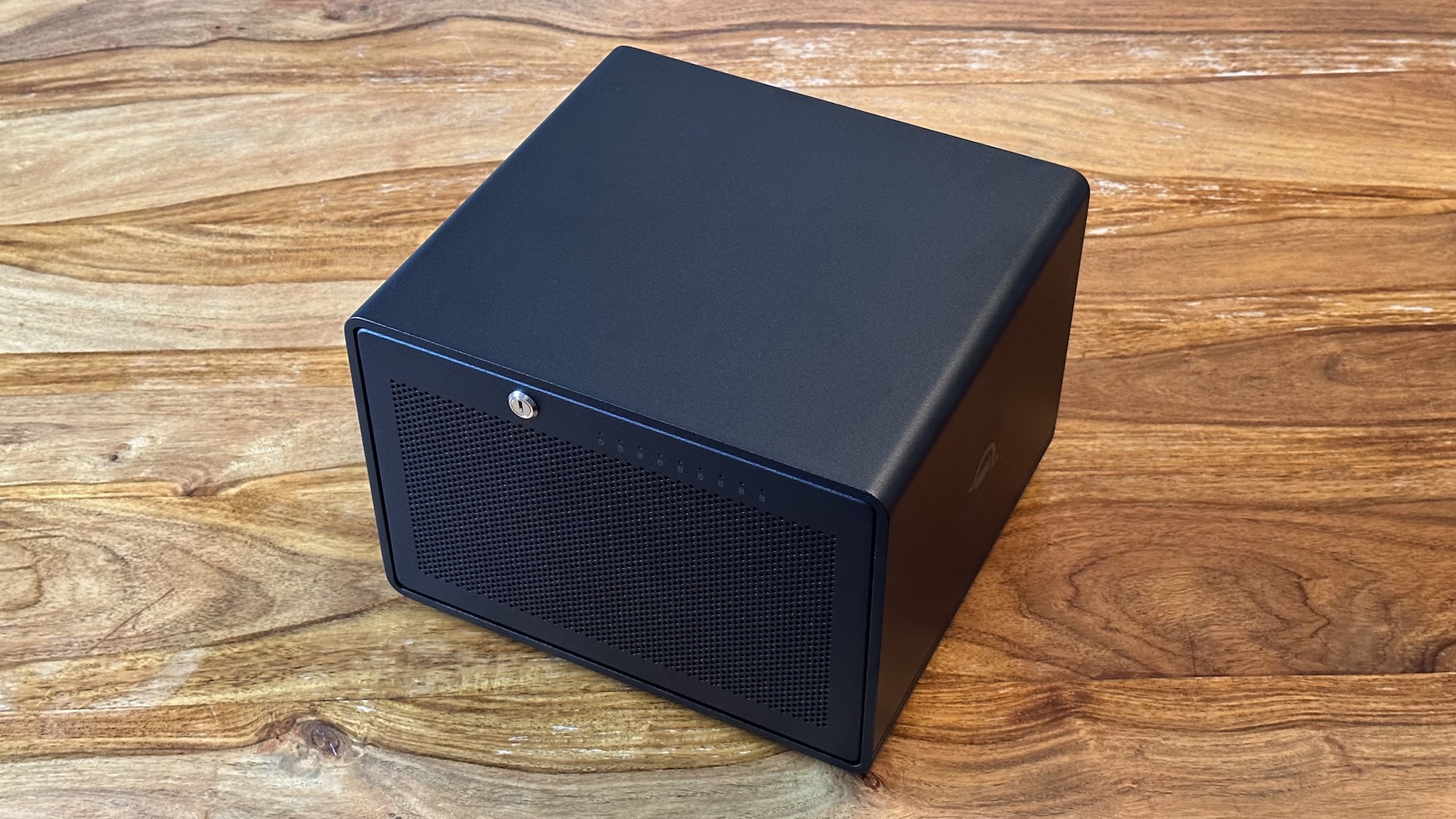
The ThunderBay 8 can serve as a high-performance personal data center with multiple configuration options to suit ever-growing storage requirements. It can accommodate the needs of individuals with data-intensive video editing, high-resolution image, and VR workflows, who need abundant drive space to store large format files, as well as fast data transfer speeds to ensure that they remain workable.
The ThunderBay 8 offers up to 160TB of storage depending on the configuration you choose, with additional options for standard and enterprise drives, pushing beyond the limits of more common four-bay storage solutions.
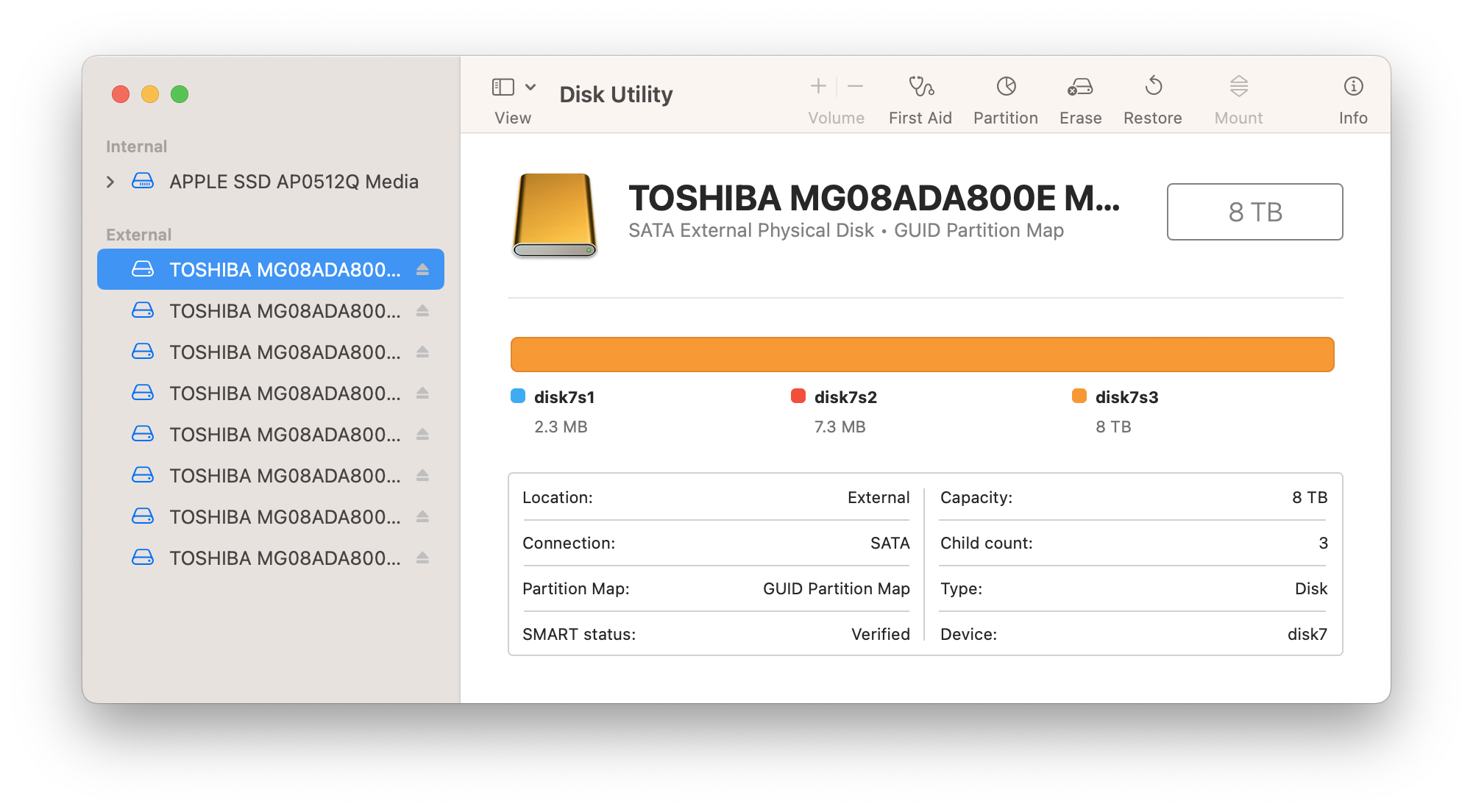
Having eight drive bays allows for greater flexibility and customization in terms of drive configuration and RAID options. Users can choose to arrange the drives in various RAID modes to optimize performance, data redundancy, or a balance of both. For example, users can choose RAID 0 for maximum performance, RAID 5 for data redundancy, or RAID 10 for a balance of both.
An enclosure with eight drive bays also cuts down on unnecessary cables and power wastage compared to single or dual drive solutions, and offers massive, highly flexible storage potential that users can scale over time.
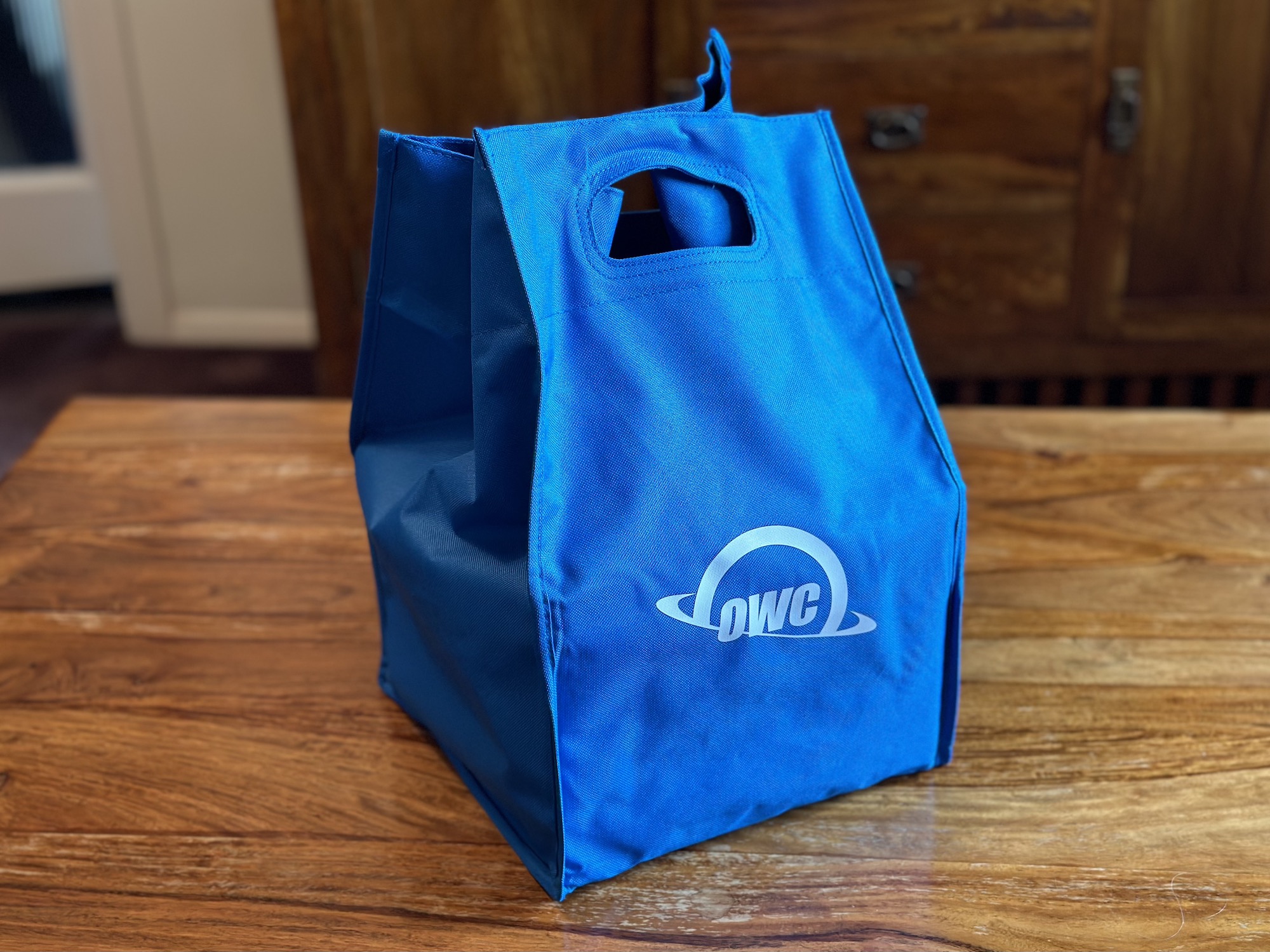
The ThunderBay 8 arrived very well packed for transit, generously using high-density foam buffers, air bags, and thick cardboard – a key consideration for transporting a large number of fairly delicate drives. The enclosure itself came in a blue woven nylon bag to help lift it out of the box, which was a much welcome aid considering it weighs almost 20 pounds. This is relatively heavy compared to some other external storage solutions, which may mean it isn't ideal for users who need good portability, even for a drive array of this size. The sturdy bag is worth definitely keeping around to help move the ThunderBay around in the future.
Design
The ThunderBay 8's enclosure is made of thick aluminium with a matte black anodized finish. The device is very well built and clearly designed for durability and heat dissipation, with plenty of opportunity to last through changes to your setup and multiple drives.
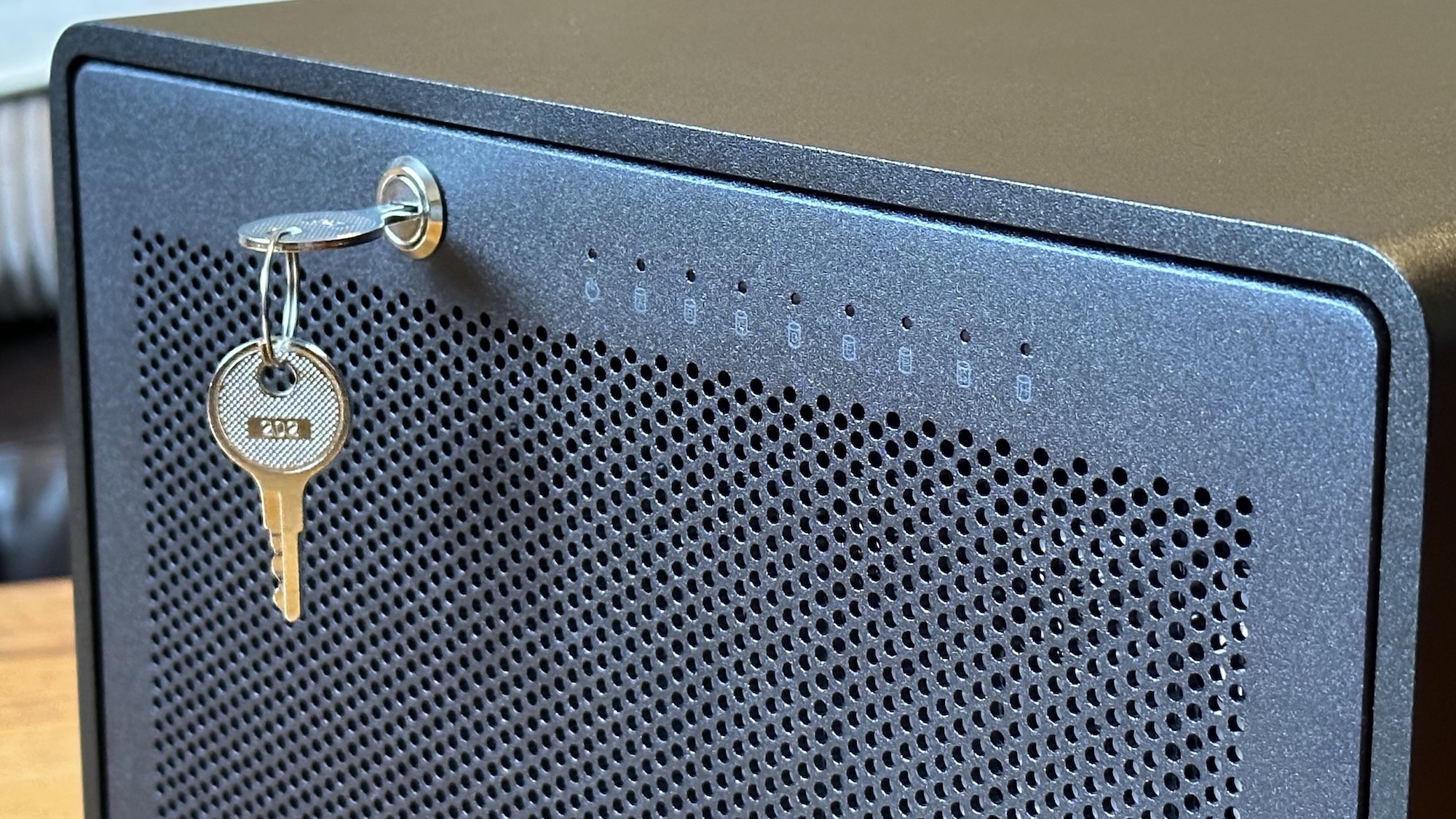
The ThunderBay comes with two keys to unlock the perforated panel at the front that leads to the hard drives. Once unlocked, you simply pull the cover up and off to get access inside.
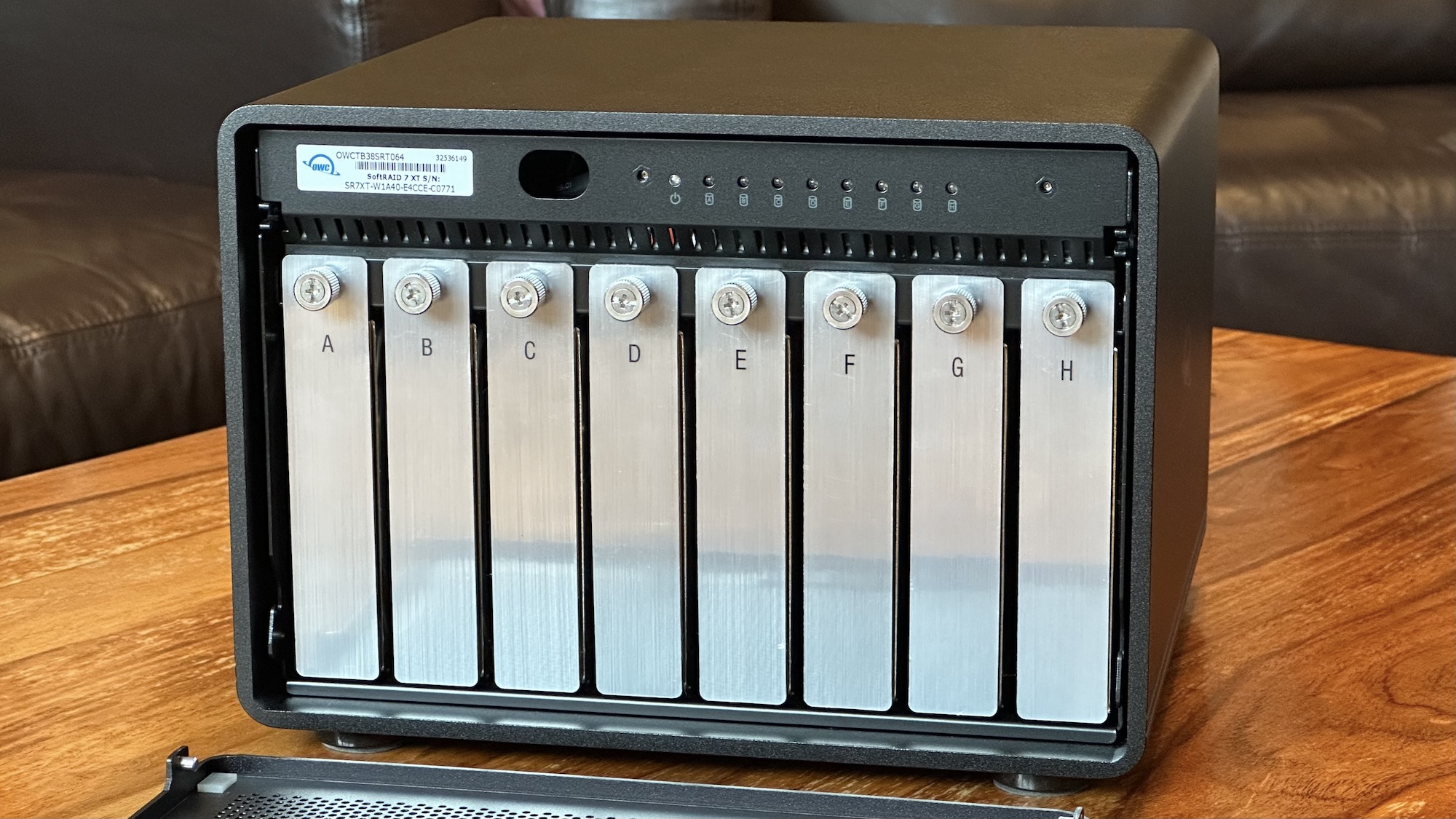
Each drive is stored in a tray, labeled A to H, that can be easily released with a thumb screw. The drives are a little difficult to remove even after they have been released, requiring quite a bit of force to come loose. Since OWC offers additional drive trays, it's possible to keep some extra drives nearby so they are ready to swap in if necessary. This could be particularly useful for repairing a RAID-5 array with minimal inconvenience.
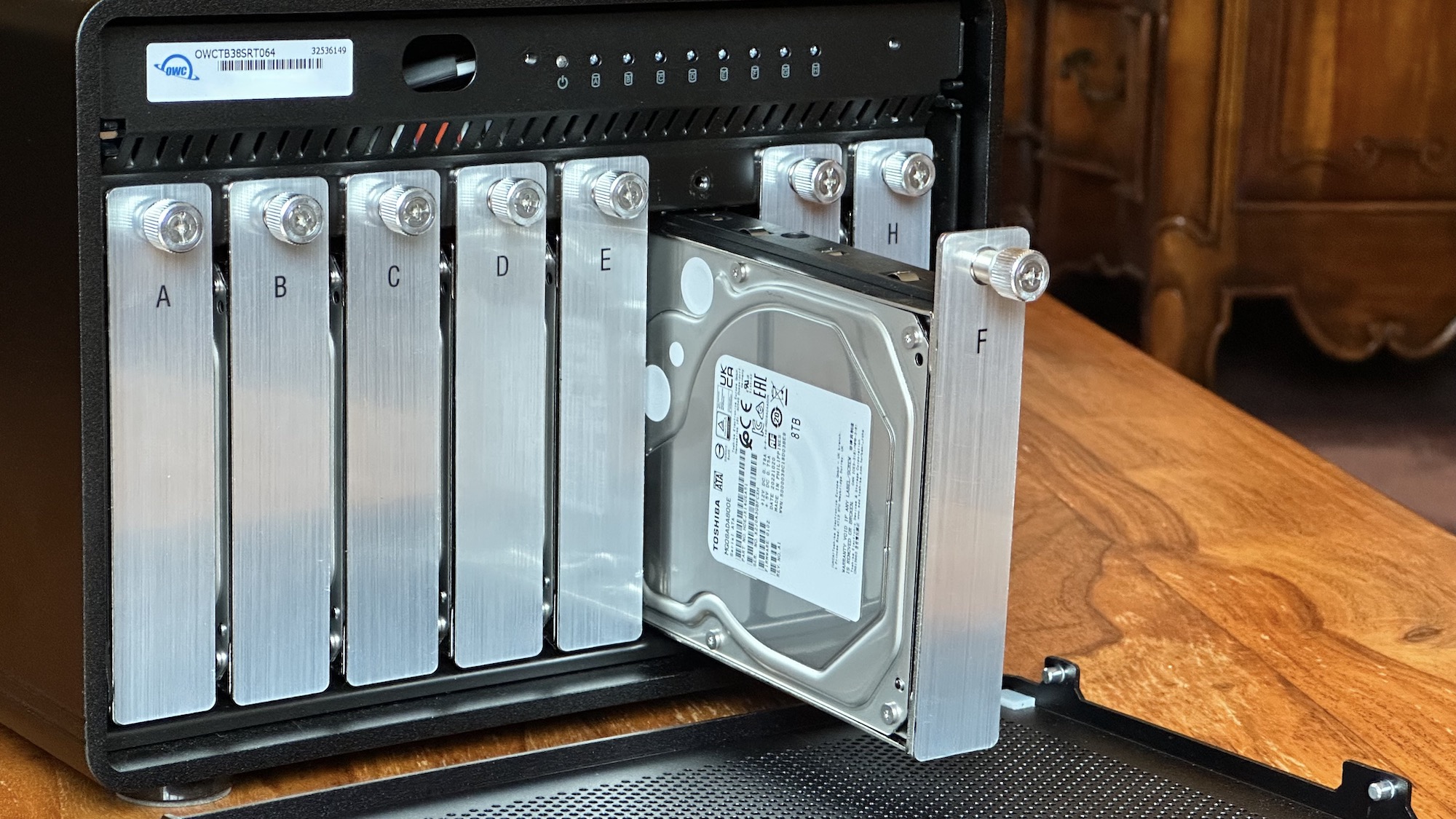
The rear of the enclosure features a Kensington lock, two Thunderbolt 3 ports, and a DisplayPort 1.2 port for connecting a display with a resolution up to 4K. Each drive has an indicator light, as do the rear ports, clearly showing when a drive or wired connection is in use. A single large fan at the back pulls in cool air.
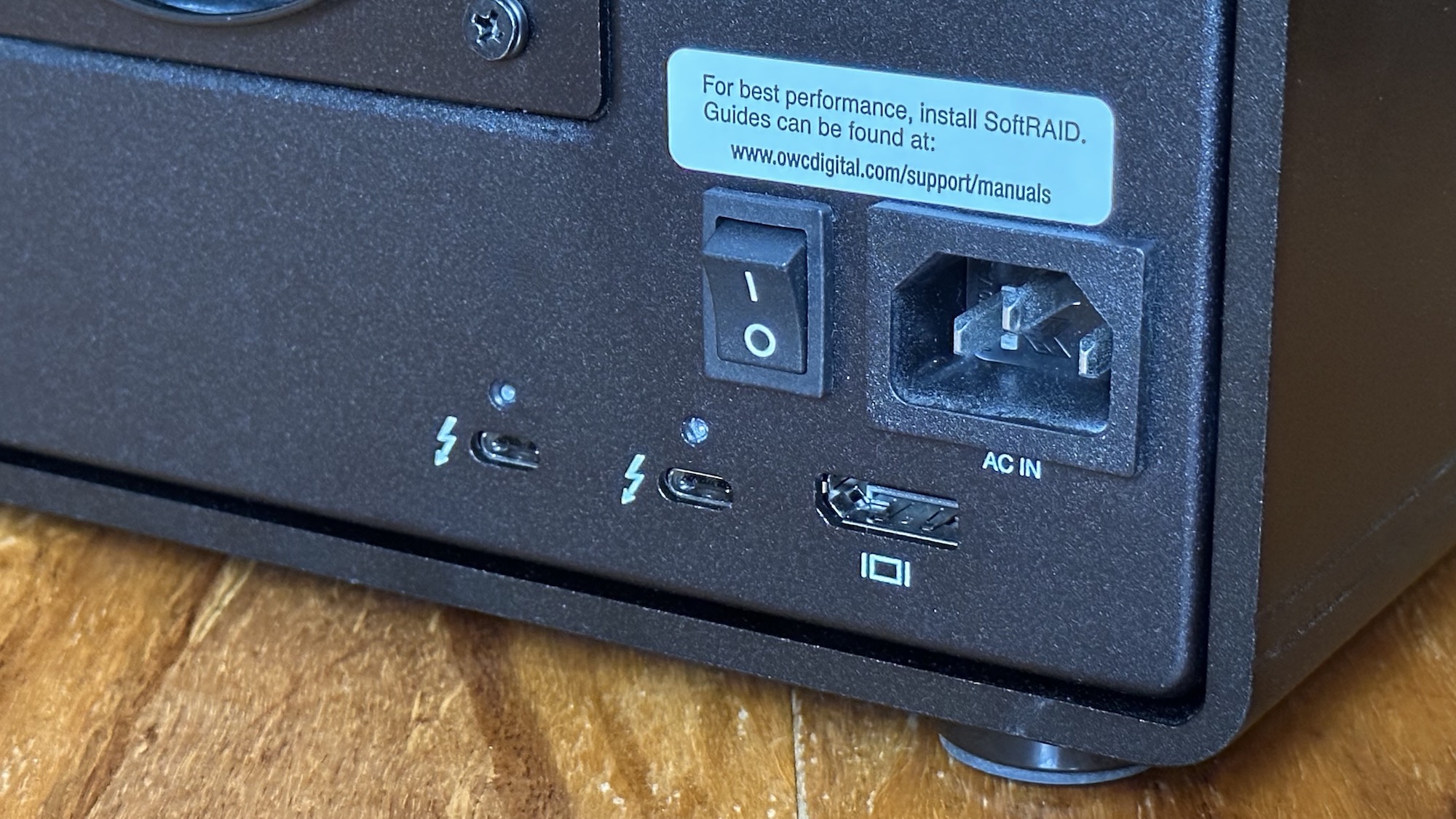
The bottom of the ThunderBay has four rubber feet to keep it secure on a surface, but also offers the opportunity to stack several ThunderBay enclosures on top of each other if you require. The power supply is integrated and there is no need for an external transformer on the power cable, which cuts down on cable mess compared to some other devices in this class.
Noise
While the OWC ThunderBay 8 is designed to be relatively quiet, some users may find that the noise level is noticeable, especially if they work in a quiet environment. It mainly comes from the fan that helps cool the drives inside the enclosure.
The fan is large and spins at a low speed, which helps reduce high-frequency noise, but it can still produce a low-frequency hum that may be noticeable in quiet environments. The fan also seems to take quite some time to turn off when the ThunderBay is idle, which some users may find a little bit annoying.
That being said, it is inevitable that eight high-capacity drives and the cooling they require will produce a certain amount of noise. The sound level is also highly dependent on the type of drives that have been installed, with faster and higher-capacity drives typically producing more noise than slower and lower-capacity drives.
While OWC has done a relatively good job at minimizing the noise the ThunderBay 8 makes, I still thought the ThunderBay was quite loud compared to other similar devices. It is easily loud enough to fill a room and even be heard in adjacent rooms – which could be a problem if you work with audio or sleep near your workstation. For this reason, some users may find it unsuitable as a desktop storage solution, especially if you think the constant clicking of the drives could irrirate you or impede your work. OWC supplies a 0.5 meter Thunderbolt 3 cable with the ThunderBay 8, which requires placing the unit quite close to the computer. It may be better to utilize a 2m Thunderbolt cable and tuck the enclosure more out of the way, if possible.
Set Up
The ThunderBay 8 is not a hardware RAID system, so it relies on SoftRAID to create, monitor, and manage RAID sets. The software allows users to configure and manage RAID arrays with ease, providing advanced features and performance enhancements over Apple's Disk Utility.
SoftRAID is theoretically not a necessity for using the ThunderBay unless you want to use the drives individually, but you will need to use it if you want to use RAID.
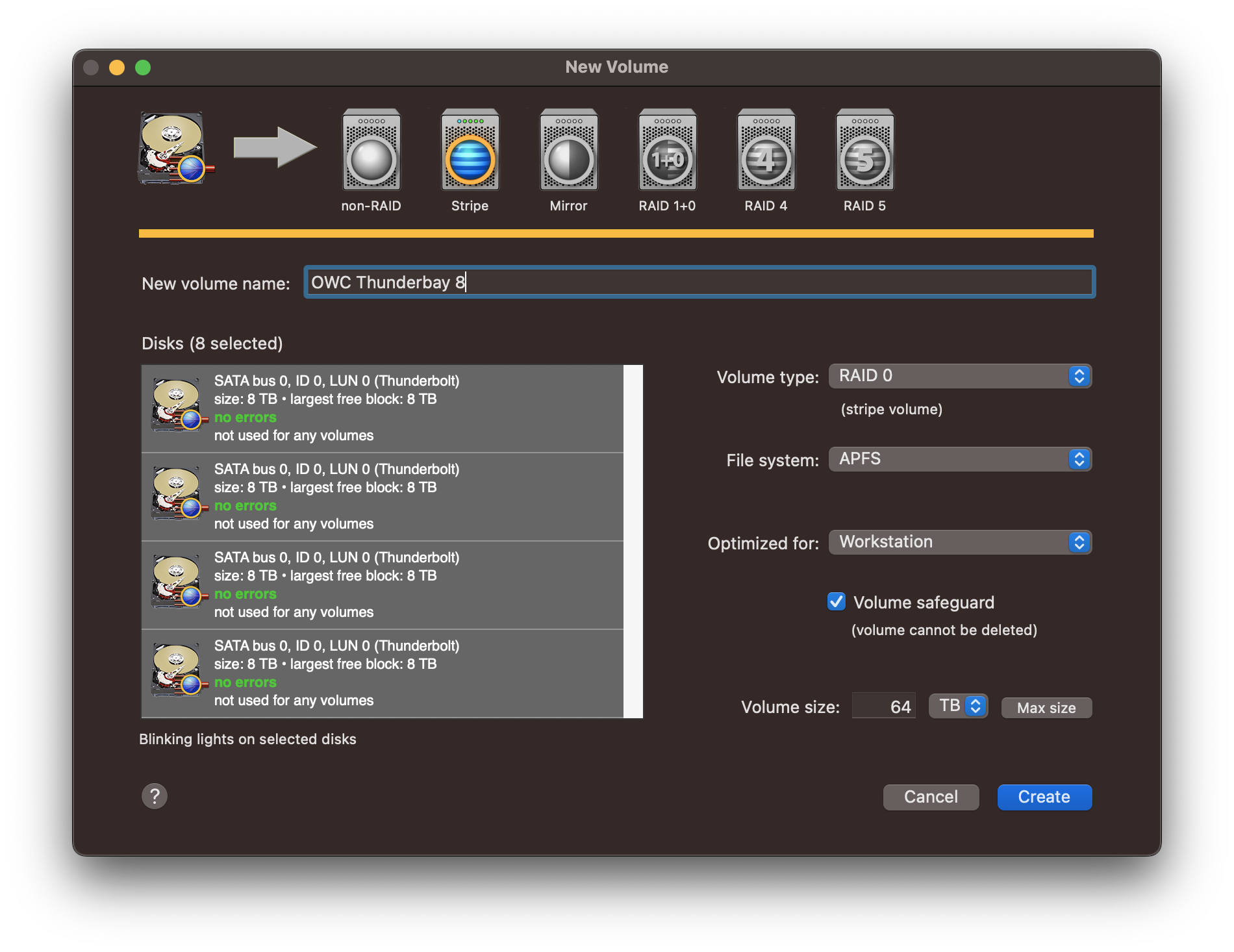
One of the key advantages of SoftRAID is performance. According to OWC, it uses advanced algorithms to optimize disk performance and provides faster data transfer rates compared to traditional hardware RAID solutions. This is particularly important for users who work with large files and high-resolution media content, as it can significantly reduce the time required to transfer and process data.
Another advantage is its ease of use. The software provides a relatively simple interface for configuring and managing RAID arrays, allowing users to create, delete, and modify arrays, with a minimal level of experience. SoftRAID also includes features like disk health monitoring, email notifications, and SMART data analysis to detect potential drive failures before they occur.
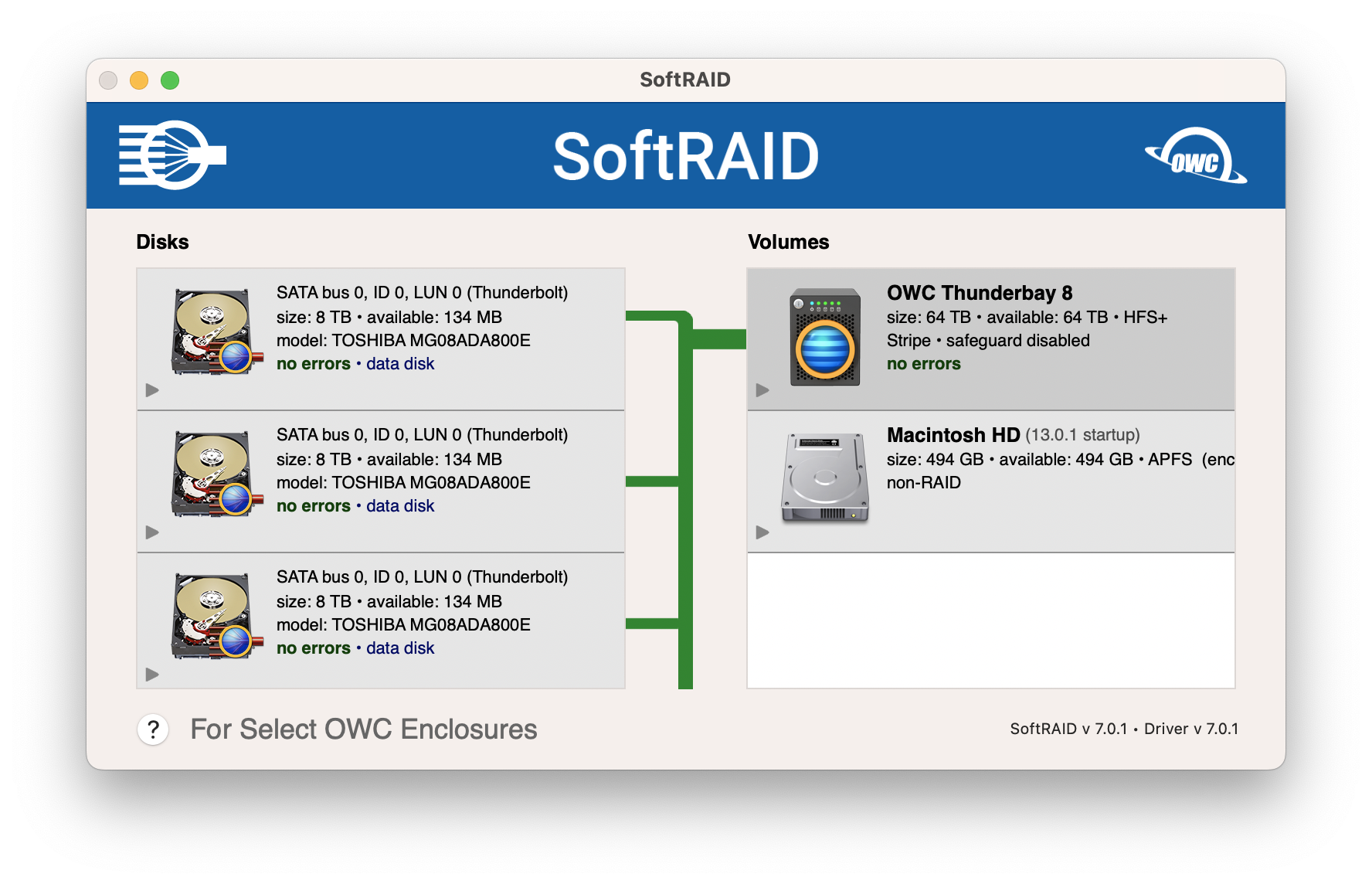
The enclosure contains a printed license number for SoftRaid XT, and it was fairly easy to install and get running, but you will need to restart and enter recovery mode to enable full disk access. My experience with SoftRAID was fairly robust, but I thought the printed instructions could have been a little more detailed and I think a newcomer could struggle a little bit with the process.
Upon connecting the ThunderBay 8 to a Mac via Thunderbolt and with SoftRAID XT installed, a RAID 5 array formatted in HFS+ appears on the desktop and is ready to use. You can then split the disks up into new RAID 0, 1, 4, 5, and 10 arrays however you see fit, and reformat as you wish.
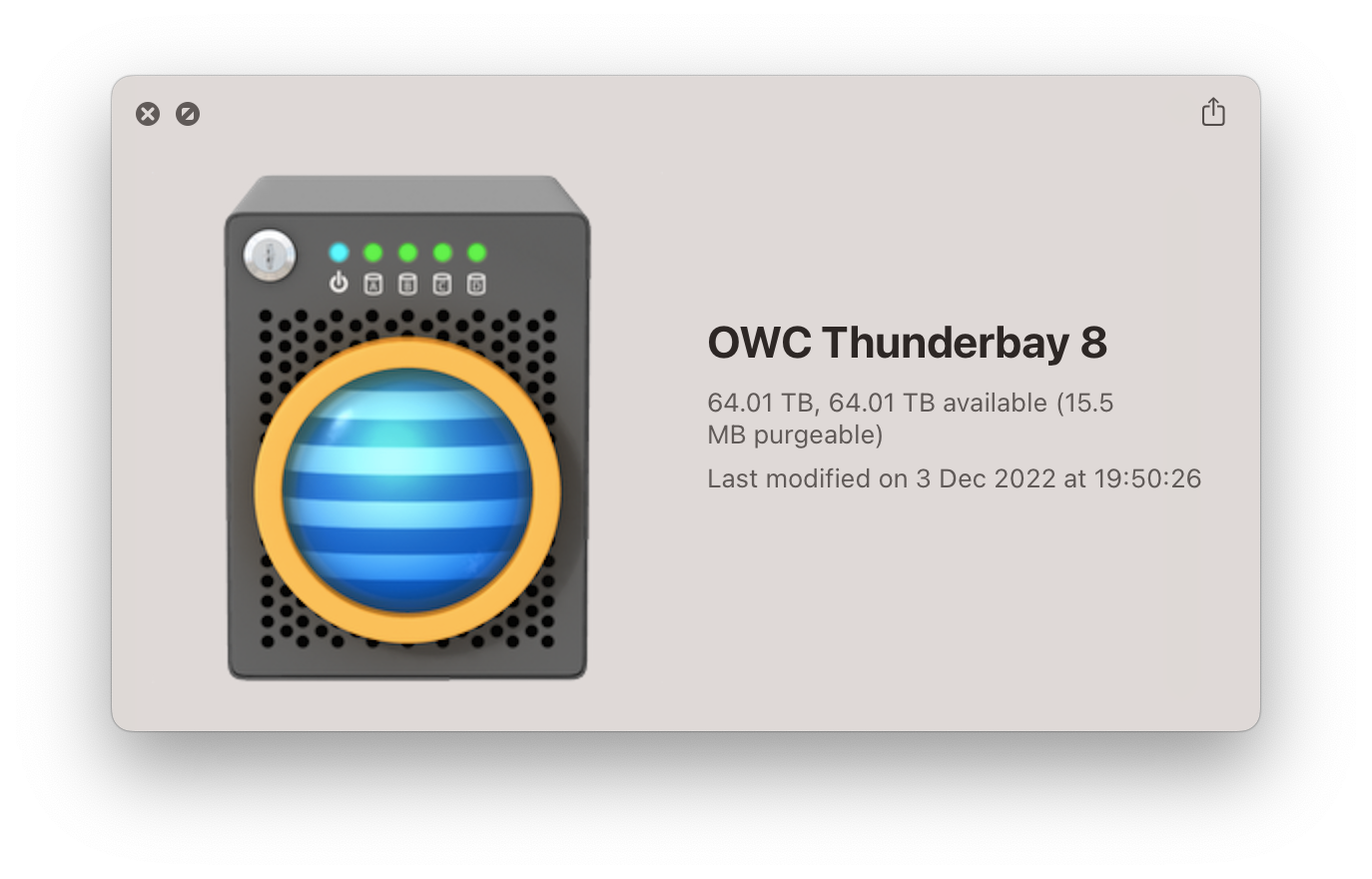
It's worth noting that the drives are not clearly labeled in SoftRAID, meaning that the only way to identify a particular drive is via the LED indicator. SoftRAID's design also feels a little bit outdated, but this could, of course, be improved via future software updates. The most important thing is that it works very reliably.
Performance
With eight bays, the ThunderBay 8 can reach up to 2,586 MB/s, according to OWC. In my series of tests, the ThunderBay 8 performed extremely well – surpassing SSD speeds via USB. With only HDDs, I achieved speeds of around 1,460 MB/s write and 1,900 MB/s read in RAID 0, which should be more than sufficient for even the most demanding professional workflows.
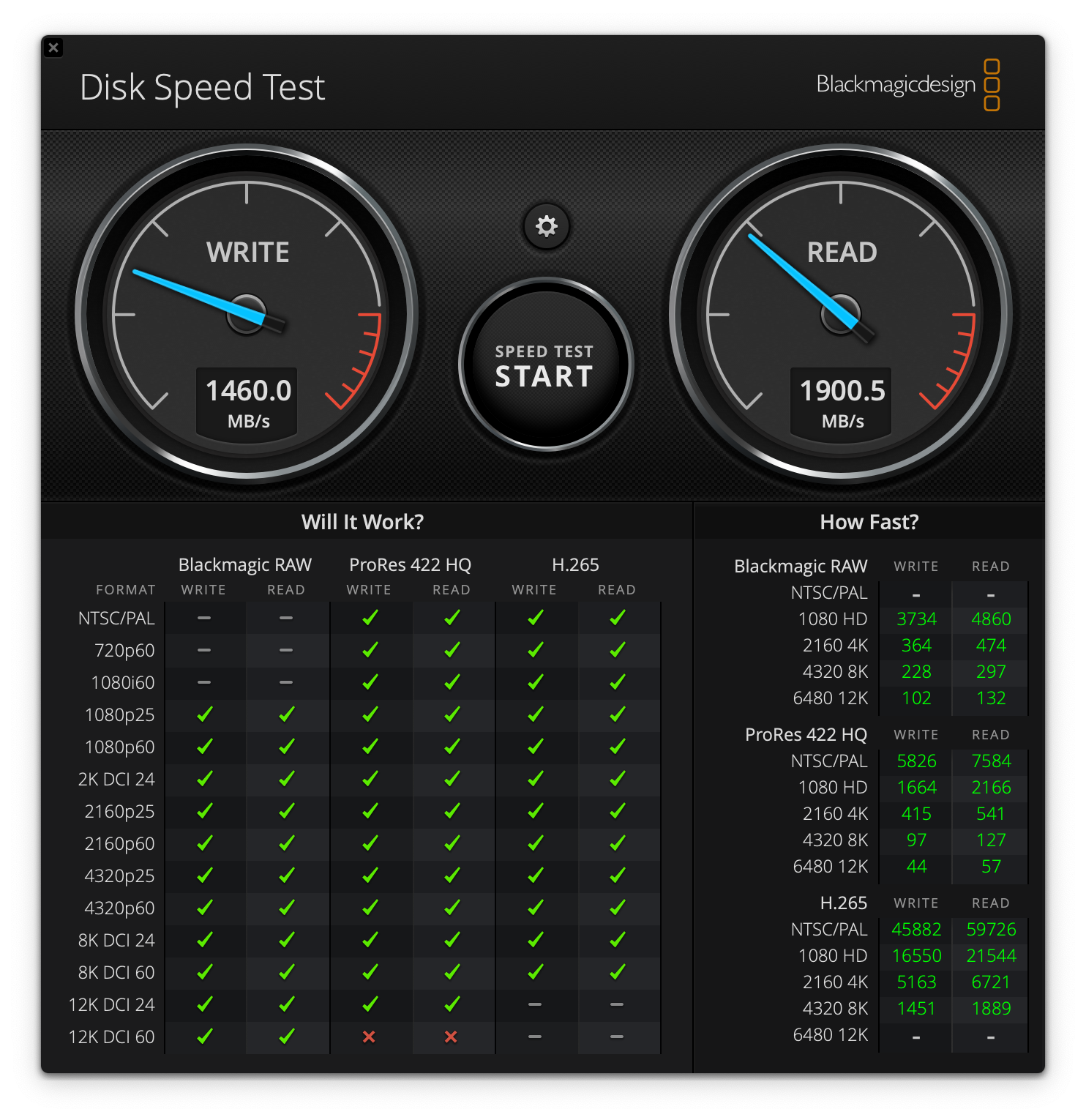
In RAID 5, this barely slowed to read and write speeds of around 1,200 MB/s and 1,150 MB/s, respectively, which is still impressive considering the added data redundancy provided by this configuration. Its fast transfer speeds and high-capacity also make it an ideal machine for Time Machine backups, although SoftRAID does not support encryption of APFS formatted arrays at this time.
Overall, this level of performance is ideal for users who work with high-resolution media content, such as 4K and 8K video, allowing for smooth playback and editing of large files. The ThunderBay 8's performance results in Blackmagic speed tests are on par with other high-performance storage solutions on the market, making it a reliable choice for professional content creators and power users who demand top-tier performance from their storage devices.
Since the ThunderBay 8 has two Thunderbolt ports, it's possible to daisy-chain other USB and Thunderbolt devices from it. I tried this with a Thunderbolt 3 SSD as well as standard USB hard drives and it worked extremely well, though I did have to remember to eject these drives before turning the ThunderBay off.
Bottom Line
Overall, the OWC ThunderBay 8 is an excellent professional-grade storage solution that works very well with the Mac, offering high-volume, high-performance storage to meet a broad range of intense demands. Across multiple RAID arrays, the device manages large libraries of video and audio production files, as well as concurrent backups, oustandingly well after months of constant use.
The ThunderBay 8 is a premium storage solution that comes at a premium price, but its features and performance justify its cost, especially for professionals who require reliable storage for their workflows. Moreover, its modular design allows for easy upgrades and maintenance, making it a long-term investment that can scale with your storage needs.
The ThunderBay 8 also comes with OWC's five-year limited warranty and customer support. If you don't need as much space as the ThunderBay 8 can provide, OWC also offers a four-bay version with the ThunderBay 4.
How to Buy
The ThunderBay 8 is available from OWC's website for a starting price of $779.00. The 16TB ThunderBay 8, which includes SoftRAID XT, starts at $1,479.00.
Note: OWC provided MacRumors with a 64TB ThunderBay 8 with SoftRAID XT for the purpose of this review. No other compensation was received.
Article Link: Review: OWC ThunderBay 8 Offers High-Volume, High-Performance Mac Storage
Got a tip for us?
Let us know
Become a MacRumors Supporter for $50/year with no ads, ability to filter front page stories, and private forums.
Review: OWC ThunderBay 8 Offers High-Volume, High-Performance Mac Storage
- Thread starter MacRumors
- Start date
- Sort by reaction score
You are using an out of date browser. It may not display this or other websites correctly.
You should upgrade or use an alternative browser.
You should upgrade or use an alternative browser.
In theory, software Raid should be no different to hardware raid today. Years ago, when CPU’s were less powerful, the XOR calculations for Raid 5 put an additional strain on the CPU. Modern CPUs have enough power that this is not an issue. It makes even less difference if you are doing raid 0 or raid 1 (stripe or mirror).
Software raid also offers advantages such as easier software upgrades and recovery of root disks (where the OS resides). Your root disk should only ever be on a Raid 1 mirror that preserves the native filesystem. That way you can always reboot your system from the alternate disk.
In regard to noise, I think the drives you buy make a big difference. A few years ago, myself and a friend bought very similar Synology two bay NAS arrays for home use. I have PTSD for noise so quiet is important to me. I had no problem with noise but he did and he replaced his with a 1 bay Synology just to reduce the noise. I think the difference is, I got slow drives and he got faster ones. Faster drives mean more noise and heat requiring more fan noise. Slower 5400 rpm drives means less noise and heat, and this will always be my choice now for a home system.
This may be the long standing MacOs timeout bug. It is the same issues as all the “Disk not ejected properly” messages that filled these forums for years.
All operating systems face a dilemma when a disk drive is not responding properly. Should the driver software keep trying, or assume the disk is failed ? Often the disk recovers. The effort the driver makes is called the “time out factor”, usually the number of times to retry or a time limit. Most commercial OS’s have long timeouts. I have seen servers with failing disks and warnings being written to log files for a year, but the disks were not yet marked as off line. A 5 minute time out is more common.
With consumer OS’s this is counter intuitively more difficult. A non IT user will pull a USB stick (which is a disk drive) and walk away. Should the OS keep probing the USB stick for (say) the next hour ? Not advisable in a consumer OS.
What Apple has done is tune down the “time out factor” to zero. When you pull the USB stick (without unmounting - ejecting) from a MacBook, Macos immediately assumes that is what you have done and displays the “Disk not ejected properly” message.
This becomes a problem if you have more substantial external drives. I have Thunderbolt drives plugged into the back of my iMac. If I adjust the monitor tilt just a little, my Thunderbolt drives go offline. If I plug in headphones, my thunderbolt drives go off line. Simply because the drive connection goes off line for a fraction of a second. To make matters worse MacOs has no easy way to re-mount the drives ; it’s easier to reboot.
I did see instructions for adjusting MacOs’s timeout factor years ago but have since given up. Sadly MacOs is now a laptop OS that is unsuitable for external drives and I am moving to NAS because TCP/IP’s timeout factor is longer than Apple’s disk driver timeout.
I am sure it would be easy for Apple to allow us to adjust the timeout factor again, but how do we ants bite the dinosaur’s tail ?
-Greg
Retired storage engineer.
PS If I were still working, I would be a ZFS engineer.
Software raid also offers advantages such as easier software upgrades and recovery of root disks (where the OS resides). Your root disk should only ever be on a Raid 1 mirror that preserves the native filesystem. That way you can always reboot your system from the alternate disk.
In regard to noise, I think the drives you buy make a big difference. A few years ago, myself and a friend bought very similar Synology two bay NAS arrays for home use. I have PTSD for noise so quiet is important to me. I had no problem with noise but he did and he replaced his with a 1 bay Synology just to reduce the noise. I think the difference is, I got slow drives and he got faster ones. Faster drives mean more noise and heat requiring more fan noise. Slower 5400 rpm drives means less noise and heat, and this will always be my choice now for a home system.
I've had issues where it disconnects if you so much as look as it funny or it loses the volume and has to rebuilt when the computer goes to sleep)
This may be the long standing MacOs timeout bug. It is the same issues as all the “Disk not ejected properly” messages that filled these forums for years.
All operating systems face a dilemma when a disk drive is not responding properly. Should the driver software keep trying, or assume the disk is failed ? Often the disk recovers. The effort the driver makes is called the “time out factor”, usually the number of times to retry or a time limit. Most commercial OS’s have long timeouts. I have seen servers with failing disks and warnings being written to log files for a year, but the disks were not yet marked as off line. A 5 minute time out is more common.
With consumer OS’s this is counter intuitively more difficult. A non IT user will pull a USB stick (which is a disk drive) and walk away. Should the OS keep probing the USB stick for (say) the next hour ? Not advisable in a consumer OS.
What Apple has done is tune down the “time out factor” to zero. When you pull the USB stick (without unmounting - ejecting) from a MacBook, Macos immediately assumes that is what you have done and displays the “Disk not ejected properly” message.
This becomes a problem if you have more substantial external drives. I have Thunderbolt drives plugged into the back of my iMac. If I adjust the monitor tilt just a little, my Thunderbolt drives go offline. If I plug in headphones, my thunderbolt drives go off line. Simply because the drive connection goes off line for a fraction of a second. To make matters worse MacOs has no easy way to re-mount the drives ; it’s easier to reboot.
I did see instructions for adjusting MacOs’s timeout factor years ago but have since given up. Sadly MacOs is now a laptop OS that is unsuitable for external drives and I am moving to NAS because TCP/IP’s timeout factor is longer than Apple’s disk driver timeout.
I am sure it would be easy for Apple to allow us to adjust the timeout factor again, but how do we ants bite the dinosaur’s tail ?
-Greg
Retired storage engineer.
PS If I were still working, I would be a ZFS engineer.
So we have DAS and NAS lovers here. But if price was the same, which is more desirable for longterm video data hoarders who want decent connection speeds to a Mac, and non-storage based transcoding (4K encoding on NAS CPU's is awful, and has massive limitations)?:
1. 6/8 bay DAS box with Tbolt 3 40gb, connected via 10m Corning optical Tbolt 3 cable to your storage cupboard (away from desk, thus no noise).
vs.
2. 6/8 bay NAS box with 10GbE, connected via 10m ethernet cable to your storage cupboard (away from desk, thus no noise).
Interesting question?
1. 6/8 bay DAS box with Tbolt 3 40gb, connected via 10m Corning optical Tbolt 3 cable to your storage cupboard (away from desk, thus no noise).
vs.
2. 6/8 bay NAS box with 10GbE, connected via 10m ethernet cable to your storage cupboard (away from desk, thus no noise).
Interesting question?
OWC is a Ripoff Company. lying to thair customers and selling them fake junk. and if its not fake its extremely overpricesThat sells fake Apple Magsafe power adapters. I bought a few and even analyzed one. 100% fake. At every level I could reach in OWC they insisted they were legit. Said the differences were due to different factories. Right....They had all the signs of a fake: light comes on immediately, weigh significantly less, smaller internal components, fit and finish, typeface/text.
I did buy one of their RAID systems a few years after I swore I would never support them. It makes a horrible buzzing sound that is normal.
Caveat empor
SoftRAID breaks in some way with every macOS update in my experience. Currently there is an issue when you lauch the SoftRAID app none of your drives appear and you cannot manage them. You must install the old version of the app and then always click No when it asks to update your driver. https://forums.softraid.com/ventura-forum/all-devices-missing-from-softraid-app/
Also, ThunderBolt cables (even the ones sold by OWC) won't fully seat in my ThunderBay 4 as the connectors sits to far in the case. If you touch the cable, or if even the wind blows on it all my drives dismount. They sent me this plastic thing with adhesive on it to help hold the cable in place, it doesn't really help much. https://eshop.macsales.com/item/OWC/CLINGON1PK/ The fact they have these let's you know there is an issue with their designs.
Also, ThunderBolt cables (even the ones sold by OWC) won't fully seat in my ThunderBay 4 as the connectors sits to far in the case. If you touch the cable, or if even the wind blows on it all my drives dismount. They sent me this plastic thing with adhesive on it to help hold the cable in place, it doesn't really help much. https://eshop.macsales.com/item/OWC/CLINGON1PK/ The fact they have these let's you know there is an issue with their designs.
Easy answer: not everyone's use case matches yours. For me, the NAS setup wouldn't be economically viable.Why anyone would buy a Thunderbolt-based solution using SoftRAID® over something like a Synology NAS is beyond me.
My setup:
OWC Thunderbay 8 with 8x Seagate Exos X18 18TB in RAID 5 via SoftRaid = 128TB for photo & video media
+ Unlimited backup of the entire array via Backblaze for $130 for 2 years (or $7/month) with 1 year deleted file storage. Once you introduce NAS into cloud backup, you start paying based off the size of your backup.
Close to the 3-2-1 backup rule, anyway.
I bought a Synology DS920+ and TB4 in January and generally pleased with both. I have fast 12TB drives in both and it is the drives that are noisy, fans relatively silent.
One inaccuracy in the article, the latest version of SoftRAID does not have email notification. I contacted OWC about this and they confirmed, I think earlier versions had this? For me this is a big issue as the TB4 is on a headless server. The Synology software is in a different league. Without email notification I can not recommend SoftRAID, I want to know asap if there is an issue and not have to manually monitor the server.
One inaccuracy in the article, the latest version of SoftRAID does not have email notification. I contacted OWC about this and they confirmed, I think earlier versions had this? For me this is a big issue as the TB4 is on a headless server. The Synology software is in a different league. Without email notification I can not recommend SoftRAID, I want to know asap if there is an issue and not have to manually monitor the server.
Been using Thunderbays for years and years without issue. I also have a Thunderbay 8, and the fan is really rubbish. I’ve been pestering OWC for years about it but they never listen. Thankfully it’s so easy to replace a fan with a Noctua and included low noise adapter, and then you’d be quite happy having this on your desk. Now, that said, hard drives are noisy little things anyway, so eight of them in one enclosure isn’t a recipe for silence.
Last edited:
That'll explain itOWC bought SoftRAID
I have a thunderbay 5 and it's super loud. I replaced the fan and it made a big difference. It annoyed me that it didn't come with the raid software although it was really expensive so all I can do is raid 0 and 1 but the first one I set up the file structure got messed up and I couldn't rename, delete or move files so I stopped using softraid.
Otherwise as a box of drive its ok, performance is average and the NVME slot in the rear is also slow with about no more speed than a traditional SSD so buying higher end NVMe drives are a waste of money. As long as your aware of the downsides these are ok but expensive imo for what they do.
Otherwise as a box of drive its ok, performance is average and the NVME slot in the rear is also slow with about no more speed than a traditional SSD so buying higher end NVMe drives are a waste of money. As long as your aware of the downsides these are ok but expensive imo for what they do.
If I were going to purchase this (I am not) I really would likely steer clear of SoftRAID, and if I needed software RAID would use the built-in software RAID in MacOS. May not be as fully featured, but at least you would be assured of continuing to work after the yearly MacOS version updates, which have broken other software regularly, such as VPNs etc. Imagine the software not being resilient to a MacOS update, not working, and meaning that the RAID was inaccessible. Nightmare scenario. What happens if / when OWC stop supporting the SoftRAID XL software? - You would be totally stuffed potentially.
With the ThunderBay 8, OWC expands its vast range of professional-grade Thunderbolt accessories, offering an ultra high-capacity storage solution with eight hot-swappable universal bays for 3.5- or 2.5-inch hard drives or SSDs.

The ThunderBay 8 can serve as a high-performance personal data center with multiple configuration options to suit ever-growing storage requirements. It can accommodate the needs of individuals with data-intensive video editing, high-resolution image, and VR workflows, who need abundant drive space to store large format files, as well as fast data transfer speeds to ensure that they remain workable.
The ThunderBay 8 offers up to 160TB of storage depending on the configuration you choose, with additional options for standard and enterprise drives, pushing beyond the limits of more common four-bay storage solutions.

Having eight drive bays allows for greater flexibility and customization in terms of drive configuration and RAID options. Users can choose to arrange the drives in various RAID modes to optimize performance, data redundancy, or a balance of both. For example, users can choose RAID 0 for maximum performance, RAID 5 for data redundancy, or RAID 10 for a balance of both.
An enclosure with eight drive bays also cuts down on unnecessary cables and power wastage compared to single or dual drive solutions, and offers massive, highly flexible storage potential that users can scale over time.

The ThunderBay 8 arrived very well packed for transit, generously using high-density foam buffers, air bags, and thick cardboard – a key consideration for transporting a large number of fairly delicate drives. The enclosure itself came in a blue woven nylon bag to help lift it out of the box, which was a much welcome aid considering it weighs almost 20 pounds. This is relatively heavy compared to some other external storage solutions, which may mean it isn't ideal for users who need good portability, even for a drive array of this size. The sturdy bag is worth definitely keeping around to help move the ThunderBay around in the future.
Design
The ThunderBay 8's enclosure is made of thick aluminium with a matte black anodized finish. The device is very well built and clearly designed for durability and heat dissipation, with plenty of opportunity to last through changes to your setup and multiple drives.

The ThunderBay comes with two keys to unlock the perforated panel at the front that leads to the hard drives. Once unlocked, you simply pull the cover up and off to get access inside.

Each drive is stored in a tray, labeled A to H, that can be easily released with a thumb screw. The drives are a little difficult to remove even after they have been released, requiring quite a bit of force to come loose. Since OWC offers additional drive trays, it's possible to keep some extra drives nearby so they are ready to swap in if necessary. This could be particularly useful for repairing a RAID-5 array with minimal inconvenience.

The rear of the enclosure features a Kensington lock, two Thunderbolt 3 ports, and a DisplayPort 1.2 port for connecting a display with a resolution up to 4K. Each drive has an indicator light, as do the rear ports, clearly showing when a drive or wired connection is in use. A single large fan at the back pulls in cool air.

The bottom of the ThunderBay has four rubber feet to keep it secure on a surface, but also offers the opportunity to stack several ThunderBay enclosures on top of each other if you require. The power supply is integrated and there is no need for an external transformer on the power cable, which cuts down on cable mess compared to some other devices in this class.
Noise
While the OWC ThunderBay 8 is designed to be relatively quiet, some users may find that the noise level is noticeable, especially if they work in a quiet environment. It mainly comes from the fan that helps cool the drives inside the enclosure.
The fan is large and spins at a low speed, which helps reduce high-frequency noise, but it can still produce a low-frequency hum that may be noticeable in quiet environments. The fan also seems to take quite some time to turn off when the ThunderBay is idle, which some users may find a little bit annoying.
That being said, it is inevitable that eight high-capacity drives and the cooling they require will produce a certain amount of noise. The sound level is also highly dependent on the type of drives that have been installed, with faster and higher-capacity drives typically producing more noise than slower and lower-capacity drives.
While OWC has done a relatively good job at minimizing the noise the ThunderBay 8 makes, I still thought the ThunderBay was quite loud compared to other similar devices. It is easily loud enough to fill a room and even be heard in adjacent rooms – which could be a problem if you work with audio or sleep near your workstation. For this reason, some users may find it unsuitable as a desktop storage solution, especially if you think the constant clicking of the drives could irrirate you or impede your work. OWC supplies a 0.5 meter Thunderbolt 3 cable with the ThunderBay 8, which requires placing the unit quite close to the computer. It may be better to utilize a 2m Thunderbolt cable and tuck the enclosure more out of the way, if possible.
Set Up
The ThunderBay 8 is not a hardware RAID system, so it relies on SoftRAID to create, monitor, and manage RAID sets. The software allows users to configure and manage RAID arrays with ease, providing advanced features and performance enhancements over Apple's Disk Utility.
SoftRAID is theoretically not a necessity for using the ThunderBay unless you want to use the drives individually, but you will need to use it if you want to use RAID.

One of the key advantages of SoftRAID is performance. According to OWC, it uses advanced algorithms to optimize disk performance and provides faster data transfer rates compared to traditional hardware RAID solutions. This is particularly important for users who work with large files and high-resolution media content, as it can significantly reduce the time required to transfer and process data.
Another advantage is its ease of use. The software provides a relatively simple interface for configuring and managing RAID arrays, allowing users to create, delete, and modify arrays, with a minimal level of experience. SoftRAID also includes features like disk health monitoring, email notifications, and SMART data analysis to detect potential drive failures before they occur.

The enclosure contains a printed license number for SoftRaid XT, and it was fairly easy to install and get running, but you will need to restart and enter recovery mode to enable full disk access. My experience with SoftRAID was fairly robust, but I thought the printed instructions could have been a little more detailed and I think a newcomer could struggle a little bit with the process.
Upon connecting the ThunderBay 8 to a Mac via Thunderbolt and with SoftRAID XT installed, a RAID 5 array formatted in HFS+ appears on the desktop and is ready to use. You can then split the disks up into new RAID 0, 1, 4, 5, and 10 arrays however you see fit, and reformat as you wish.

It's worth noting that the drives are not clearly labeled in SoftRAID, meaning that the only way to identify a particular drive is via the LED indicator. SoftRAID's design also feels a little bit outdated, but this could, of course, be improved via future software updates. The most important thing is that it works very reliably.
Performance
With eight bays, the ThunderBay 8 can reach up to 2,586 MB/s, according to OWC. In my series of tests, the ThunderBay 8 performed extremely well – surpassing SSD speeds via USB. With only HDDs, I achieved speeds of around 1,460 MB/s write and 1,900 MB/s read in RAID 0, which should be more than sufficient for even the most demanding professional workflows.

In RAID 5, this barely slowed to read and write speeds of around 1,200 MB/s and 1,150 MB/s, respectively, which is still impressive considering the added data redundancy provided by this configuration. Its fast transfer speeds and high-capacity also make it an ideal machine for Time Machine backups, although SoftRAID does not support encryption of APFS formatted arrays at this time.
Overall, this level of performance is ideal for users who work with high-resolution media content, such as 4K and 8K video, allowing for smooth playback and editing of large files. The ThunderBay 8's performance results in Blackmagic speed tests are on par with other high-performance storage solutions on the market, making it a reliable choice for professional content creators and power users who demand top-tier performance from their storage devices.
Since the ThunderBay 8 has two Thunderbolt ports, it's possible to daisy-chain other USB and Thunderbolt devices from it. I tried this with a Thunderbolt 3 SSD as well as standard USB hard drives and it worked extremely well, though I did have to remember to eject these drives before turning the ThunderBay off.
Bottom Line
Overall, the OWC ThunderBay 8 is an excellent professional-grade storage solution that works very well with the Mac, offering high-volume, high-performance storage to meet a broad range of intense demands. Across multiple RAID arrays, the device manages large libraries of video and audio production files, as well as concurrent backups, oustandingly well after months of constant use.
The ThunderBay 8 is a premium storage solution that comes at a premium price, but its features and performance justify its cost, especially for professionals who require reliable storage for their workflows. Moreover, its modular design allows for easy upgrades and maintenance, making it a long-term investment that can scale with your storage needs.
The ThunderBay 8 also comes with OWC's five-year limited warranty and customer support. If you don't need as much space as the ThunderBay 8 can provide, OWC also offers a four-bay version with the ThunderBay 4.
How to Buy
The ThunderBay 8 is available from OWC's website for a starting price of $779.00. The 16TB ThunderBay 8, which includes SoftRAID XT, starts at $1,479.00.
Note: OWC provided MacRumors with a 64TB ThunderBay 8 with SoftRAID XT for the purpose of this review. No other compensation was received.
Article Link: Review: OWC ThunderBay 8 Offers High-Volume, High-Performance Mac Storage
Also, ThunderBolt cables (even the ones sold by OWC) won't fully seat in my ThunderBay 4 as the connectors sits to far in the case. If you touch the cable, or if even the wind blows on it all my drives dismount. They sent me this plastic thing with adhesive on it to help hold the cable in place, it doesn't really help much. https://eshop.macsales.com/item/OWC/CLINGON1PK/ The fact they have these let's you know there is an issue with their designs.
Your second issue (and others here) may be an example of the disk driver time out issue. It’s a MacOS bug and happens to all vendors. Your OWC drives may have a sub optimal connection, but MacOS should be tolerant of this. See post #52
I have the same NAS, it's greatNo thanks. I'm happy with my Synology 1621+ with 10GB ethernet connection.
They like it because it is CHEAP. It cost nothing to manufacture software, but "doing it right" requires powerful hardware inside the box. Generally, you need a processor with 32-bits and at least dual cores to get the level of performance needed. Software simply costs less.Why OWC likes SoftRAID?
Compare this $700 box with a Synology NAS. To get the same performance on the NAS, first you need 10 GBe on both the NAS and the Mac. Many Macs have Thunderbolt but lack 10Gbe. Then the NAS needs at least a low-end quad-core CPU and some RAM. This makes the NAS solution a few hundred dollars more.
But for the higher cost you get more too. For example the backup softwar runs on the NAS and I can share the files with every computer I own and I can also run other low-end servers of the NAS, like a low-end Windows 11 desktop server.
There is a use case fr both solutions. A soft-raid solution costs less, this is importent fro many people. Also if you only own one computer, sharing files is not needed.
Summary" The question is "why soft RAID?" the answer is "lower cost".
Sounds great, except: "additional OWC drive trays (sold separately)". I can't find out how many are included, but they are $15.00 a piece, so add potentially $120 to the cost for 8 trays.
Still, this sounds like a good box, but it's not a NAS box. *shrug*
Still, this sounds like a good box, but it's not a NAS box. *shrug*
No thanks. I'm happy with my Synology 1621+ with 10GB ethernet connection.
Apples to oranges. It's not a NAS box, but could be shared.
It's not.Your second issue (and others here) may be an example of the disk driver time out issue. It’s a MacOS bug and happens to all vendors. Your OWC drives may have a sub optimal connection, but MacOS should be tolerant of this. See post #52
I have the 4 bay version of this and really like it. SoftRAID is a bit buggy though, and does cause the occasional KP.
Using this unit for over a year and just installed the second unit: 100% satisfied. Installed Raid5 with softraid XT (second unit can be installed with the same licence, no extra cost). it is used to replace a drobo installation, which seems to be not supported anymore.
Speed measurements depend on the disk you are using. I am not reaching the numbers in this article. So it would be nice to hear, which HDs were used. My figures with 8x8TB disks 700ß rpm CRM were Write 550, Read 1100 MB/sec.
Big advantage: no extra power supply all inside.. (no clutter on your installation).
For an experienced drobo user, there is one caveat, if you change: you can not easily add more drives whithout having to delete the existing drives (it is not a OWC issue, but a general for RAID-installation). So it is recommended to fill in all 8 slots with the same size, same HD.
Support: i used the Chat support several times, always solving my problems immediately. Great service. (Chat hat no wating in line…)
Hope this system will last for a longer period. Would be interested of experience about real speed figures for raid5 with that kind of HD.
Speed measurements depend on the disk you are using. I am not reaching the numbers in this article. So it would be nice to hear, which HDs were used. My figures with 8x8TB disks 700ß rpm CRM were Write 550, Read 1100 MB/sec.
Big advantage: no extra power supply all inside.. (no clutter on your installation).
For an experienced drobo user, there is one caveat, if you change: you can not easily add more drives whithout having to delete the existing drives (it is not a OWC issue, but a general for RAID-installation). So it is recommended to fill in all 8 slots with the same size, same HD.
Support: i used the Chat support several times, always solving my problems immediately. Great service. (Chat hat no wating in line…)
Hope this system will last for a longer period. Would be interested of experience about real speed figures for raid5 with that kind of HD.
SoftRAID, where you're one OS update away from having all 160TB of your data inaccessible! No hardware RAID no deal, next!
I'm skeptical about those bandwidth ratings. Are those benchmarks actually based on reading and writing to the physical disks? At speeds like that I suspect that there's a lot of caching happening in system RAM or on the system's SSD, and it'd be interesting to see what the benchmarks show for different read/write sizes.
EDIT: Oh, on a reread I see it was RAID-0. Okay, that makes sense that such speeds would be possible on spinning disks.
EDIT: Oh, on a reread I see it was RAID-0. Okay, that makes sense that such speeds would be possible on spinning disks.
Register on MacRumors! This sidebar will go away, and you'll see fewer ads.


